-

人教版新目标初中英语七年级下册Where is your pen pal from教案
2.1Match the country with the language.Step II Reading3a? let the students read the letter fast and answer the questions.? Let the students ask more questions about the letter as possible as the can.Step III Writing3b.Step IV. Pairwork2cStep V Listening2a, 2bStep V. HomeworkExercises book(1) P3Exercises book (2) P3Period FourStep I . Dictate the words and sentences in Unit1.Step II. Self-checkStep III. Check the answers for Exercises book in the unit.Step IV. Home workRevise and preparation for unit 2.教学反思:通过本单元的学习,学生基本可以谈论人们的国籍,居住城市及其所说的语言,通过书信方式去介绍自己并寻找笔友。但在涉及到国外的一些城市时,学生对这方面的知识相对欠缺,能介绍的城市并不多,也反应出学生课前预习不充分,这跟学生学习条件也有关,大多数学生无法通过网络获取所需信息。因此,在以后的教学中要多指导学生通过计算机网络获取信息,拓宽知识面。

人教版新目标初中英语八年级上册Can you come to my party教案3篇
Step 3 (3b)First, tell the students when we talk about our future plans, we often use: I’m+verb+ing When we talk about what we must do, we use have to. Ask the students to fill in the blanks in 3b. The answers are: shopping, go to see, a test, I’m going, my family. Step 4 (3c)Let the students write an e-mail message to a friend. Say why you can’t visit next. Before the exercise, ask the students to give some possible answers and write them on the blackboard. So the students will feel easy to finish the writing exercise. After they finish it, Let them to correct it in groups first. Each group chooses theirs best one to read in front of the whole class. Step 5 ( planning a party )First read the conversation in the box together. Then ask the students to turn to page 88.Write down everything you have to do next week. Write in all the things you have to do . Ask the students to look at the list. Ask them “What day are you free?” This is when you can have your party. Step 6 (Self check 1 )Let the students to fill in the blanks with the words given. Change the forms of the words if possible. Then make their own sentences. The answers are: visit, playing, have to, study, comeStep 7 (Self check 2)Imagine you are Marie. Read the information and look at your schedule. Write replies to the invitation.

人教版新目标初中英语八年级下册Have you ever been to an amusement park教案
(1)Have you ever been to …? Yes, I have. / Yes, I have ever been to …No, I haven’t. / No, I have never been to …(2)When did you go there? I went there last year. (3)I have never been to a water park. Neither have I. I have ever been to an amusement park. So have I. (4)How long have you been studying English? I’ve been studying English since nine o’clock. I’ve been studying English since I came back home. I’ve been studying English for five hours. (5)What’s that? It’s an amusement park in Japan. I’ve never been to an amusement park like it before. It’s fun to learn another language. Let’s go tonight. Isn’t this great?space museum, amusement park, water park, South America, Peru, Holland, European culture, tour guide, flight attendant, musical instrument, more than, be from, get to, take lessons, neither, discover, graduate, change

人教版新目标初中英语八年级下册What were you doing when the UFO arrived教案2篇
(一).知识方面: 1.培养学生能运用过去进行时来描述、谈论过去某个时间正在发生的事情或动作的意识和能力,能就过去某个时间正在发生的动作做出正确的描述。 2.培养学生的想象力和角色扮演的合作能力。 3.培养学生讲述过去发生的事情经过的能力。能正确运用一般过去时来讲述故事。 (二).技能方面: 1.本单元的语言目标是Talk about past events and tell a story(谈论过去的时间和讲述一个故事),围绕这一目标,要涉及句型: What were you doing when the UFO arrived? ----I was sitting in the barber’s chair. The barber was cutting my hair. 因此必须学习standing、studying、cleaning、sleeping、cooking、making、eating、cutting、等表示地点的词,以便为上述句型提供语言材料。2.学习过去进行时的有关知识。Was/were+现在分词,是该时态的表达式。 3.在学习过程中,要区分The boy was walking down the street when the UFO landed.和While the boy was walking down the street, the UFO landed.这两种由when和while引导的状语从句的句型结构。注意它们的不同。

人教版新目标初中英语九年级上册Teenagers should be allowed to choose their own clothes教案2篇
Step 1 Greeting Greet the class and check the homeworkStep 2 A duty report The S on duty gives a report on the rules in his home and lead in 3a “Sun Fei’s and Wu Yu’s rules” Step 3 ReadingSs read the conversation and write the two girls’ rules in the chart. Check the answers.Get Ss to read after the tape and then read aloud by themselves. Then, T explains the language points.Step 4 Pairwork 3bRole play. Use the information in chart to practice with the conversation in 3a covered. They can look at the sample conversation in the right box.Step 5 Task 2 “Who’s the best reporter?”Make a survey by asking any 5 students the questions in the chart in activity 4. Then give out a report about it. See who is the best reporter? And the best reporter will get a nice ball-pen.Step 6 Summary and homework:Write out the report in your exercise-books.Period ThreeStep 1 Greeting and a duty reportThe S gives a duty report talking about his experience of being late for school. Lead in the question “Do you ever get to school late? How often do you get to school late? Always, usually, sometimes, or never?Step 2 1a Get Ss to finish writing.Step 3 Pairwork 1b Get Ss to talk about their answers with their partners using the sample conversation in the box on the right.Step 4 Listening practice2a Lead-in: What will happen if you get to school late? What about Peter? Let’s listen to a conversation between Peter and his father. Get Ss to finish 2a (As usual, for the first time, Ss only listen.) Check the answers.

人教版新目标初中英语九年级下册By the time I got outside, the bus had already left教案
Ⅰ. Teaching Aims and Demands1. Knowledge Objects(1) Key Vocabularyoversleep(2) Target LanguageWhat happened?I overslept. And by the time I got up, my brother had already gotten in the shower.2. Ability Objects(1) Teach the students to use the new words.(2) Train the students to narrate past events with the Past Perfect Tense.(3) Train the students' listening and speaking skills with the target language.3. Moral ObjectIt’s a good habit to go to bed early in the evening and get up early in the morning. So you’ll never be in a hurry in the morning.Ⅱ. Teaching Key Points1. Key Vocabularyoversleep2. Target LanguageNarrate past events with the Past Perfect TenseⅢ. Teaching Difficult Points1. Train the students to narrate past events with the Past Perfect Tense.2. Train the students to understand the target language in spoken conversation.Ⅳ. Teaching Methods1. Thinking of examples from the students' real lives.2. Making sentences by looking at the pictures.Ⅴ. Teaching AidA tape recorderⅥ. Teaching ProceduresStep I Revision1. Revise the language points in Unit 8.Ask some questions like this: What volunteer work would you like to do?Help the students to answer, I’d like to…/I love to…/I hope to2. Practice the dialogue in Activity 3c on page 62 again. Get students to role play the similar dialogues with the following.

人教版新目标初中英语九年级下册We’re trying to save the manatees教案2篇
本单元主要围绕着有关濒临灭绝的动物这一话题,学习了应该怎样保护我们的环境,以及就某一问题展开辩论。目标提示语言目标能够运用所学知识,就某一问题展开辩论。认知目标1、复习一些语法:现在进行时、一般现在时、用used to 表示一般过去时、现在完成时、一般过去时的被动语态。2、学会表达同意和不同意。3、学会以下基本句型:We’re trying to save the manatees.Manatees eat about 100 pounds of food a day.There used to be a lot of manatees.In 1972,it was discovered that they were endangered.Some of the swamps have become polluted.情感目标了解一些濒临灭绝的动物的生活习性和濒临灭绝的原因,教育学生应该如何保护环境。教学提示充分利用多媒体等教学设备,创设与本课话题相关的情境,如各种不同种类的动物、动物园以及有关环境的画画等等。围绕着本单元的教学目标,设计一些贴近学生实际的教学任务,如让学生谈论自己最喜欢的动物,如何拯救濒危动物,如何保护环境等等。让学生根据所学知识,就动物园是否对动物有利以及其他的话题进行辩论。

人教版新目标初中英语九年级下册You’re supposed to shake hands教案
教学目标:1. 掌握本单元一些重点词汇的写法和用法。2. 学会自如谈论餐桌礼仪。Step 1 RevisionAsk some students to retell the customs at the table in France in the passage in 3a.Step 2 Self checkPart 1. Fill in each bland with the correct word given. Students do the exercises by themselves at first. Then check the answers. Ask the students to comprehend the sentences and help them point out uses of some words, like “arrive (at / in) sw., spend time / money on sth , spend time / money (in) doing sth.”Part 2. Read about Fan Ling’s experience in a western restaurant. Understand the passage. Point out some key points in the passage.1. be / get used to doing sth. 习惯做某事2. begin with = start with 以….开头3. crowd v. 挤满,塞满 the crowd 人群 crowded adj. 拥挤的Then students discuss about how she would solve her problem. Ask some to share their stories with others.Part 3. Complete the crossword by looking at the sentences on the left. Then check the answers.
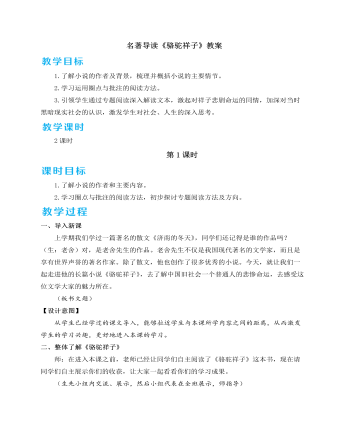
人教部编版七年级下册名著导读 《骆驼祥子》 圈点与批注教案
本环节交流的内容侧重于体验与心得,是建立在充分阅读后的再创作,也是对小说阅读方法和内容的总结性归纳和展示,需要学生有较高的阅读理解能力。三、延伸探讨《骆驼祥子》的艺术特色师:同学们,了解经典作品的艺术魅力,然后能运用到自己的写作中,是何等快乐的事啊!请你根据自己的阅读体验,概括对《骆驼祥子》这部小说艺术特色的评价。(生小组内交流、讨论,然后推荐代表在全班交流,师明确)预设 (1)结构紧密,线索分明。(2)语言朴实自然,生动明快,具有鲜明的地方色彩和浓厚的生活气息。幽默和“京味儿”语言运用熟练。(3)善于运用各种描写方法(肖像、心理、环境描写等)来表现人物的思想性格及发展变化。(4)有深厚的文化底蕴。写北京的生活,北京的车夫,北京种种的风俗人情等。在炎凉的世态中揭示地方文化。
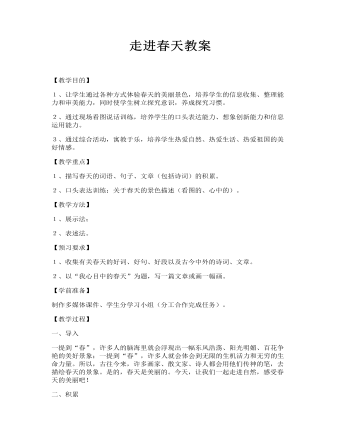
走进春天教案
【教学重点】1、描写春天的词语、句子、文章(包括诗词)的积累。2、口头表达训练:关于春天的景色描述(看图的、心中的)。【教学方法】1、展示法;2、表述法。【预习要求】1、收集有关春天的好词、好句、好段以及古今中外的诗词、文章。2、以“我心目中的春天”为题,写一篇文章或画一幅画。
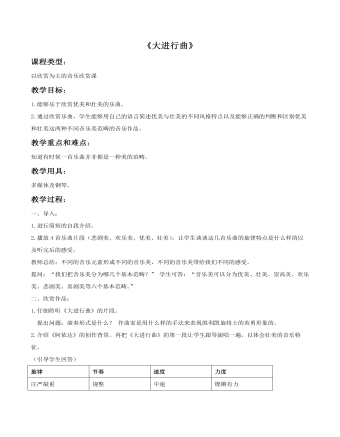
《大进行曲》教案
教学过程:一、导入:1.进行简短的自我介绍。2.播放4首乐曲片段(悲剧美、欢乐美、优美、壮美),让学生谈谈这几首乐曲的旋律特点是什么样的以及听完后的感受。教师总结:不同的音乐元素形成不同的音乐美,不同的音乐美带给我们不同的感受。提问:“我们把音乐美分为哪几个基本范畴?”学生可答:“音乐美可以分为优美、壮美、崇高美、欢乐美、悲剧美、喜剧美等六个基本范畴。” 二、欣赏作品:1.仔细聆听《大进行曲》的片段。 提出问题:演奏形式是什么? 作曲家是用什么样的手法来表现胜利凯旋将士的英勇形象的。2.介绍《阿依达》的创作背景。再把《大进行曲》的第一段让学生跟琴演唱一遍,以体会壮美的音乐特征。(引导学生回答) 旋律节奏速度力度庄严凝重规整中速铿锵有力3.简单介绍创作者以及剧情。4.通过欣赏《大进行曲》片段,来分析主奏乐器。以及分析进行曲的几个主要特点。5.下课。

大班社会《我喜欢我》教案与说课
整个教育活动我设计了三个环节:第一个环节,谈话引入,拉近师生关系,激起幼儿认真听讲,大胆回答问题的信心。出示哭泣的青蛙,引起幼儿学习兴趣,第二个环节借助图片讲故事,引导幼儿发现动物们各自的本领,帮助伤心难过的青蛙寻找优点,逐渐感知、体会故事中所蕴含的“我就是我,谁也代替不了”的道理。第三个环节,鼓励幼儿大胆在别人面前讲述自己的本领,展现自己的本领,并引导幼儿发现自己身上不被关注的优点,为幼儿提供表现自己的长处的机会,增强自尊心和自信心,师生互动、生生互动,教师和孩子们的评价直接影响着幼儿的自我价值感,让每个孩子感受赞美和被赞美的快乐。从而大胆的告诉别人“我喜欢我自己”,让自己更加的自信!整个活动,给孩子们创造一个轻松、快乐的氛围,以提高孩子们与别人交流的自信心。更重要的是将自信培养教育渗透到幼儿生活当中,引导幼儿正确地认识自我,评价自我。活动中有不当之处,敬请各位评委和老师批评指正。
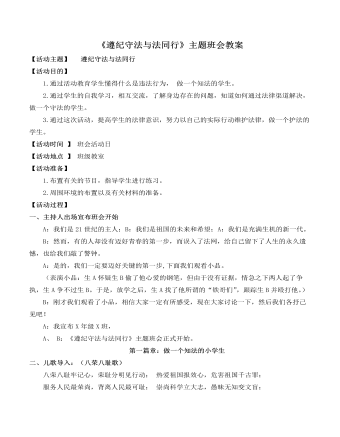
《遵纪守法与法同行》主题班会教案
【活动地点 】 班级教室【活动准备】 1.布置有关的节目,指导学生进行练习。2.周围环境的布置以及有关材料的准备。【活动过程】一、主持人出场宣布班会开始A:我们是21世纪的主人;B:我们是祖国的未来和希望;A:我们是充满生机的新一代。B:然而,有的人却没有迈好青春的第一步,而误入了法网,给自己留下了人生的永久遗憾,也给我们敲了警钟。A:是的,我们一定要迈好关键的第一步,下面我们观看小品。 (表演小品:生A怀疑生B偷了他心爱的钢笔,但由于没有证据,情急之下两人起了争执,生A争不过生B。于是,放学之后,生A找了他所谓的“铁哥们”,跟踪生B并殴打他。)B:刚才我们观看了小品,相信大家一定有所感受,现在大家讨论一下,然后我们各抒己见吧!A:我宣布X年级X班,A、 B:《遵纪守法与法同行》主题班会正式开始。
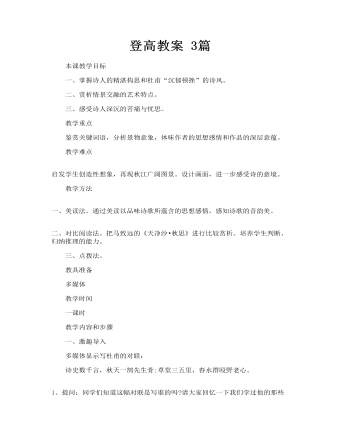
登高教案 3篇
一、激趣导入 多媒体显示写杜甫的对联: 诗史数千言,秋天一鹄先生骨;草堂三五里,春水群殴野老心。 1、提问:同学们知道这幅对联是写谁的吗?请大家回忆一下我们学过他的那些作品?能背诵一首我们共同欣赏吗?(学生背诵)今天我们来学习他的另一首诗歌《登高》(板书)

《青藏高原》教案
这是作曲家张千一创作的一首歌曲。以明朗高亢而富有藏族风格的旋律,热情地歌颂了美丽庄严的青藏高原,表达了对祖国锦绣山川的眷恋、热爱之情。全曲为羽调式;节拍以四四拍子为主,间插以四二、四三拍子,引子为散板;曲式结构为有引子、前奏的二段体。引子开始,由人声合唱出一个明朗、高亢、山歌风的衬腔,把人们带入到辽阔的青藏高原的意境之中。接着,由器乐演奏深化了这一音乐主题。A段由起承转合的四个乐句构成。第一乐句作为全曲音乐主题的集中体现,具有秀美、明亮、亲切的特征;第二乐句继续承接着这一特征,切分节奏的运用使之更具活力;第三乐句作为一个转折,主要在前半句的音区和旋律音调上发生了变化,较低的音区和较为低回委婉的旋律,使感情表达更显真挚;第四乐句开头出现的后半拍起唱的节奏,使之既富有变化,又富有动力,后半乐句的旋律与第二乐句的结尾相同,使之具有“合”部的特征。

《黄土高坡》教案
(一)学生随《乡下的阳光》进教室,师生问好。(二)聆听《黄土高坡》、《洞庭鱼米乡》。1、引入:我们生活在江南,你有没有在电影或电视中看到我国黄土高原?出示地图,找一找黄土高坡的位置。(在我国西北)2、在《黄土高坡》背景音乐下,展示CAL课件中的黄土高原的风土人情的图片:(1)漫漫黄土,低矮的窑洞。(2)沙尘漫漫飞舞。(3)人们在劳动。3、师:是啊,虽然黄土高原自然条件恶劣,但世代居住在这里的人们依然热爱他们的家乡,热爱他们的这一片土地,让我们听听他们的歌《黄土高坡》。设问:这首歌曲给你什么感受?4、刚才我们到了黄土高坡,现在我们一起去有“鱼米之乡”的洞庭湖吧。一起在地图上找一找洞庭湖的位置。(在我国中南)(课件播放洞庭湖区秀丽风景和人们张网捕鱼的图片。(同时播放《洞庭鱼米乡》背景音乐。)
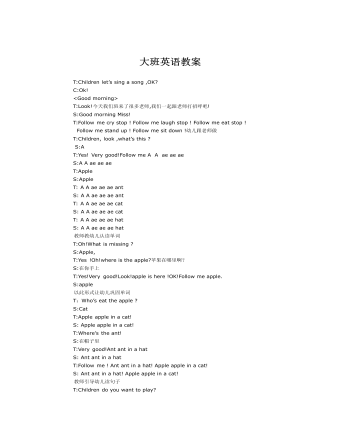
英语公开课教案
<Good morning> T:Look!今天我们班来了很多老师,我们一起跟老师打招呼吧! S:Goodmorning Miss! T:Follow mecry stop ! Follow me laugh stop ! Follow me eat stop ! Follow me stand up ! Follow me sit down !幼儿跟老师做 T:Children,look ,what’s this ? S:A T:Yes! Verygood!Follow me A A ae ae ae S:A A ae aeae T:Apple S:Apple T: A A ae aeae ant S: A A ae aeae ant T: A A ae aeae cat S: A A ae aeae cat T: A A ae aeae hat S: A A ae aeae hat
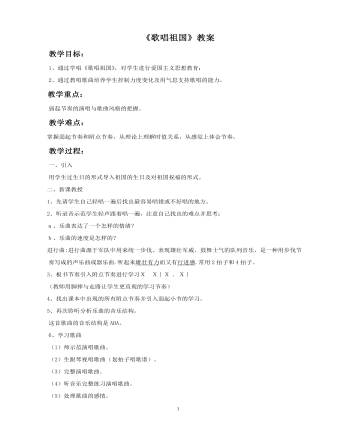
《歌唱祖国》教案
一、引入用学生过生日的形式导入祖国的生日及对祖国祝福的形式。 二、新课教授1、先请学生自己轻唱一遍后找出最容易唱错或不好唱的地方。2、听录音示范学生轻声跟着唱一遍,注意自己找出的难点并思考:a、乐曲表达了一个怎样的情绪?b、乐曲的速度是怎样的?进行曲:进行曲源于军队中用来统一步伐、表现雄壮军威、鼓舞士气的队列音乐,是一种用步伐节奏写成的声乐曲或器乐曲.听起来雄壮有力而又有行进感.常用2拍子和4拍子。3、板书节奏引入附点节奏进行学习X X|X . X|(教师用脚摔与走路让学生更直观的学习节奏)4、找出课本中出现的所有附点节奏并引入弱起小节的学习。5、再次聆听分析乐曲的音乐结构。这首歌曲的音乐结构是ABA。
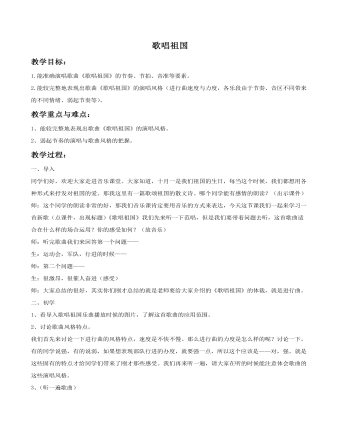
《歌唱祖国》教案
导入同学们好,欢迎大家走进音乐课堂。大家知道,十月一是我们祖国的生日,每当这个时候,我们都想用各种形式来抒发对祖国的爱。那我这里有一篇歌颂祖国的散文诗。哪个同学能有感情的朗读?(出示课件)师:这个同学的朗读非常的好,那我们音乐课肯定要用音乐的方式来表达,今天这节课我们一起来学习一首新歌(点课件,出现标题)《歌唱祖国》我们先来听一下范唱,但是我们要带着问题去听,这首歌曲适合在什么样的场合运用?你的感受如何?(放音乐)师:听完歌曲我们来回答第一个问题——生:运动会,军队,行进的时候——师:第二个问题——生:很激昂,很催人奋进(感受)师:大家总结的很好,其实你们刚才总结的就是老师要给大家介绍的《歌唱祖国》的体裁,就是进行曲。
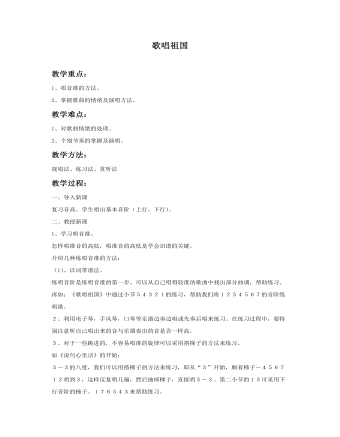
《歌唱祖国》教案
简介作品:《歌唱祖国》王莘作词作曲,作于1950年9月。歌曲表现了中华人民共和国朝气蓬勃、蒸蒸日上的新面貌,记录了刚刚解放的中国人民雄壮前进的步伐。歌词凝练集中,具有鲜明生动的形象;旋律气势豪迈而充满深情,连贯统一有富于变化,在继承聂耳、冼星海革命群众歌曲传统的基础上,创造了新时代的新风格歌曲有长度相等的主、副歌组成,主歌每段歌词不同,表现了同一主题的不同侧面;副歌歌词不变,是歌曲主题集中的体现,两者再节奏、结构、音调诸方面形成强烈的对比,是一首具有深刻思想性,又具有高度艺术性的祖国颂歌。几十年来,这首歌传遍了祖国大地,已成为独立自由的新中国的象征。
